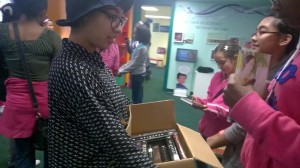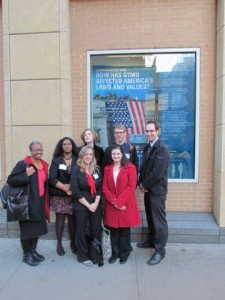Rethinking diversity: Modupe Labode and Juanita Moore
20 November 2014 – Angela Thorpe
This is the second post in a series on issues of diversity in the public history field. Each post in this series is based upon oral interviews conducted with public history professionals. Each interview was conducted in a traditional interview question and answer format. All interviews were edited and condensed based on relevancy and to retain a reasonable length for the posts.
I began my exploration of this topic by interviewing two public historians who have proven track records addressing diversity issues in public history: Modupe Labode, Assistant Professor of History and Museum Studies at Indiana University-Purdue University Indianapolis, and Juanita Moore, President and CEO of the Charles H. Wright Museum of African-American History in Detroit, Michigan.
At the National Council on Public History (NCPH) Annual Meeting in 2009, Labode helped spearhead a working group titled “How do we get there? Racial and ethnic diversity in the public history profession,” which served as a platform to “discuss the profession’s lack of diversity and share ideas about remedying the situation.”[1] As the CEO and President of the nation’s largest African American history museum, Moore has achieved a stellar career as a public historian of color, and she remains committed to mentoring and providing opportunities to other public historians as they enter the field. My conversations with each of these women demonstrated that though some changes have been made, there is still much work to be done to bolster the field of public history to include those from diverse backgrounds.
Why does our field suffer from a lack of diverse professionals?
According to Labode, individuals that are historically underrepresented in museums are generally underrepresented in the humanities field. This plays a major part in reflecting what we see in public history. Consider Moore’s point that, for a while, museum professionals did not come from fields as specific as public history or even from graduate programs. Thus, the field potentially fails to attract diverse professionals because they may be engaged in fields or graduate programs without direct links to public history. Furthermore, many are unsure of how to enter the field in the first place. I can attest to this issue: as an undergraduate student, neither my academic mentors nor advisors were able to point me in the direction I needed to take to pursue museum work. It was only after I endured several exhaustive appointments with a career counselor and took a series of online exams that prearranged my career goals that I was even made aware of public history.
In addition to the confusion of discovering public history graduate programs, Labode adds that we fail to see diverse students in these programs because the programs themselves are often unsure of how to go about recruiting these students. In a complementary point, Moore argues that it is not always productive for public historians to wait for public history “superstars” to emerge triumphantly from graduate programs. Rather, training, mentorship, and seeking budding professionals out of direct line with the field is necessary.
Moore charges public historians to broaden who they recruit and bring into their institutions, as phenomenal public historians likely exist outside the bounds of public history programs. Seasoned public historians must be willing to step up to the plate to make this happen–if this is done, perhaps our field might witness change.
Is the “diversity issue” important to the future of public history?

An intern doing programming with young students at the Charles H. Wright Museum of African American History. Photo credit: Juanita Moore
Diversity in public history is critical to cultural institutions. Labode argues that the greater difference in our field, the more questions we are able to ask of our sources, and the more perspectives we are able to represent and consider in our institutions. Similarly, Moore highlights what I understand as “the danger of a single story”: if our institutions remain committed to telling only the stories they’re comfortable interpreting, they may lose relevance among the public that they serve. Labode also makes clear that diversity is not one-dimensional: it is crucial that the ranks of public historians are diversified in a number of ways, including gender, sexual orientation and identity, and nationality. Overall, public historians must consider diversity from a variety of angles, address the questions it raises, and respond to these questions in an attempt to create richer, more meaningful institutions.
Is the field obligated to diversify?
In a word, “No.” Our institutions will continue to exist without diverse practitioners. Yet according to Labode, for our institutions to do “good” history and to attract diverse audiences, they should want to diversify. Institutions should feel pressed to consider what diversity means to them and act on this. Museums may also face the dilemma of the conflation of having a racially diverse support staff versus professional staff. According to Moore, institutions should consider whether or not they reflect–in their exhibits and programs and amongst their professional staff–the communities they serve. If not, they have a blueprint to work with to begin making internal change. Overall, if we wish for the field to grow, remain accessible, and retain support, we have to be more inclusive of those who wish to practice public history.
Who is responsible for diversifying public history?
Everyone! Really–this is a widespread issue that requires the collaborative efforts of individual practitioners, graduate programs, institutions, and professional organizations. Yet, according to Moore, in order for change to be made, people and organizations alike must begin to take ownership of the issue and prompt “live” discussions about it. Labode engaged in such a live discussion during the 2009 Panel “How do we get there? Racial and ethnic diversity in the public history profession.” It was a productive way of bringing the issue to the surface, she notes. Five years later, the implications of the session, and its impact on the field, are still being assessed and remain complex. A new generation of practitioners is taking their place in museums. Moreover, museums are still feeling the lingering effects of the recession, making diversity a “luxury issue” as opposed to an essential one for some. Historical agencies, museums, and societies are also increasingly run by non-public historians, who are not attuned to diversity as an issue in the field, or not used to thinking about diversity in the workforce as a crucial agenda item. Yet, interest in racially diverse topics remains, giving public historians leeway to continue and remain consistent with this discussion.
What can we do to remedy this issue?
Talking about this issue, although somewhat productive, is not enough–we must act on it and remain creative in our solutions. As Labode notes, one solution isn’t cross-applicable. She suggests that graduate programs need more coherent plans to attract students from different backgrounds to their programs–for instance, perhaps putting funding towards supporting diverse students or implementing evidence-based recruiting strategies to show how training diverse students affects the field. She, along with Moore, also notes that graduate programs could make stronger alliances with undergraduate-serving institutions to demonstrate what public history is to a broader student base.
Programs could also partner with museums and historic sites to promote mentorship and internship initiatives and fellowship programs to encourage matriculation into the field. Cultural organizations and museums in North Carolina, Minnesota, and Illinois have already implemented programs and partnerships of the sort, providing various models to graduate programs. Ultimately, graduate programs should maximize their efforts by compounding resources and creating alliances with other organizations and programs. “Remember,” Moore notes, “students come to history in very different ways.”
Larger organizations must make concrete efforts to encourage the diversification of public history. For example, NCPH’s various committees have diversity funds, which can be applied to encourage or increase diversity in a number of ways, notes Labode. Larger organizations could also make efforts to engage with scholarship initiatives, training programs, or commit to internal proposals to remedy the diversity issue. Overall, large organizations, in conjunction with graduate programs and individual practitioners, must work together to propose solutions, follow through with them, and remain consistent in their efforts to diversify public history.
[1] Modupe Labode, “Diversity, Here to There,” Public History News, September 2009, 7.
~ Angela Thorpe is a graduate of the Museum Studies MA program at the University of North Carolina at Greensboro. She is an oral history researcher with The HistoryMakers African American video oral history archive in Chicago, IL.





I appreciate Public History Commons addressing this ongoing matter. In cultural institutions, fields, and resource management programs throughout the nation this discussion occurs regularly. There is a paralysis in seeking diversity and inclusion, because the question becomes “at what cost?” which infers many things. Understanding what diversity is for your program/institution (time, resources), intentionally moving outside of traditional avenues for your recruiting and engagment efforts, and being OK with the backlash that comes when institutions do so.
Two intriguing comments within the article for me were that the issue of diversity was a “luxury item” with institutions recovering from the recession and that the field has no obligation to diversify, because it will continue on whether or not the change occurs. Thank you for this series.
Thank you for your thoughtful comments, Brian! I am so grateful that Angela has undertaken this project and initiated a wider dialogue.
I’d like to expand a bit on my comments about diversity being seen as a “luxury” item. In the late 1990s and early 2000s, the AAM and other organizations undertook some much needed and valuable conversations about diversity within the profession. The excellent “Mastering Civic Engagement” (2002) was one of the results of this initiative https://aam-us.org/ProductCatalog/Product?ID=239 . My perception (which I cannot quantify) is that during the economic downturn, many museums and public history sites either tried to commodify civic engagement and diversity efforts or cut back on the staff and/or initiatives. The (perhaps unintended) message such actions is that diversity is not essential to an organization’s health.
My comment about cultural institutions’ perception that they have no obligation to diversity is a reference to a common argument which states that cultural institutions will need to diversity their staff and programming to prepare for demographic shifts in which the United States will become a majority-minority country. It is not clear to me that such arguments have persuaded institutions to make sustained change. It’s important to note, however, that Imagining America (and other like-minded groups) make compelling and sophisticated arguments for the ongoing importance of diversity in cultural organizations.